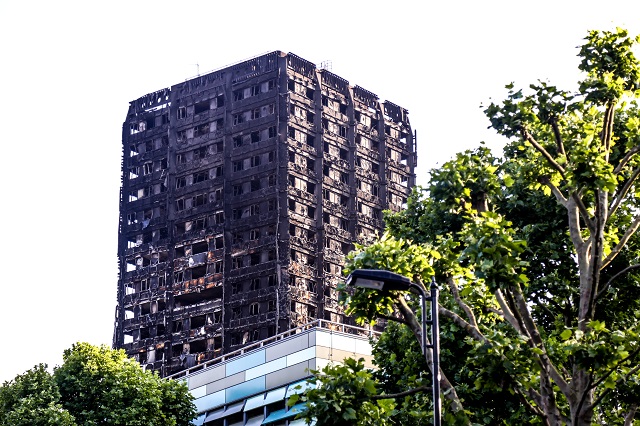
In the small hours of June 14, a fire started on the second floor of Grenfell Tower, a 24-story public housing block in London’s Kensington neighborhood. Within minutes, the structure became fully engulfed in flames that spread quickly through the building, which housed 120 apartments.
The fire might have been yet another tragedy in a year filled with terrible news, but for one thing: Some of the survivors, as well as other critics, claim it could have been prevented.
NPR estimates that up to 600 people may have been sleeping inside the building when the fire broke out, and survivors testify that they fled with moments to spare — ignoring the building’s fire plan, which directed residents to stay inside units behind allegedly fireproof doors. Observers witnessed people jumping from windows, and at least one infant was tossed from the tenth floor and caught by a bystander on the ground.
While the fire is still being investigated, survivors are raising a number of claims.
The first involves the decorative cladding on the building, which was added during a recent remodel to make the building more visually appealing — with evidence showing that it was selected with an eye to satisfying wealthier Londoners concerned about their views. This cladding, however, may have helped the fire accelerate and spread. The London Fire Brigade had an in fact warned public housing councils in London about the use of such material, saying it contributed to a terrible fire in 2016.
Meanwhile, residents say they’d warned of fire risks before and been ignored. They were particularly concerned about the building’s single stair case, which hampered rapid exit from the building and made it harder for firefighters to respond.
Tenants noted that Grenfell Tower didn’t have an alarm or sprinkler system, which also made it difficult to respond quickly as the flames spread. Some survivors would have been left in the building, unaware of the fire until it was too late, if neighbors hadn’t knocked on their doors.
Though 200 firefighters and over 40 trucks responded to the scene, along with medical services, they were hampered by equipment that failed to reach higher than the 11th floor. Some reports also state that the pipework in the building wasn’t working properly.
Routine inspection and servicing of fire safety systems is critical in any building — particularly a large residential structure, where an out-of-control fire could spread quickly and with devastating effect.
A constellation of factors clearly contributed to the aggressive and lethal nature of this fire, with a death count of at least 17 by Thursday afternoon — a number that will likely grow as investigators move through the building.
Clearly, there were maintenance and structural issues with the building that made it unsafe. Critics say public housing is often shabbily maintained because occupants are low-income — and frequently people of color.
As London responds, this situation raises an important question: How many other public housing estates across the city have similarly unsafe conditions, with obvious correctable issues that could be addressed to make them much safer? After years of austerity, how many buildings are suffering from deferred maintenance that exacerbates these problems?
In 1911, New York’s infamous Triangle Fire, which killed 146 garment workers — mostly women — forced dramatic changes in the city’s fire and building codes. London is no stranger to fire, but the Grenfell Tower tragedy could be a catalyst for much-needed updates to the city codes designed to prevent incidents like this from happening.
Take Action!
Urge the UK Housing Minister to immediately review the safety of tower blocks by signing this Care2 petition.
Defying Trump’s right-wing agenda from Day One
Inauguration Day is here, and at Truthout, we plan to defy Trump’s right-wing agenda from Day One.
Looking to the first year of Trump’s presidency, we know that the most vulnerable among us will be harmed. Militarized policing in U.S. cities and at the borders will intensify. The climate crisis will deteriorate further. The erosion of free speech has already begun, and we anticipate more attacks on journalism.
It will be a terrifying four years to produce social justice-driven journalism. But we’re not falling to despair, because we know there are reasons to believe in our collective power.
The stories we publish at Truthout are part of the antidote to creeping authoritarianism. And this year, we promise we will kick into an even higher gear to give you truthful news that cuts against the disinformation, vitriol, hate and violence. We promise to publish analyses that will serve the needs of the movements we all rely on to survive the next four years, and even build for the future. We promise to be responsive, to recognize you as members of our community with a vital stake and voice in this work.
Please show your support for Truthout with a tax-deductible donation (either once today or on a monthly basis).